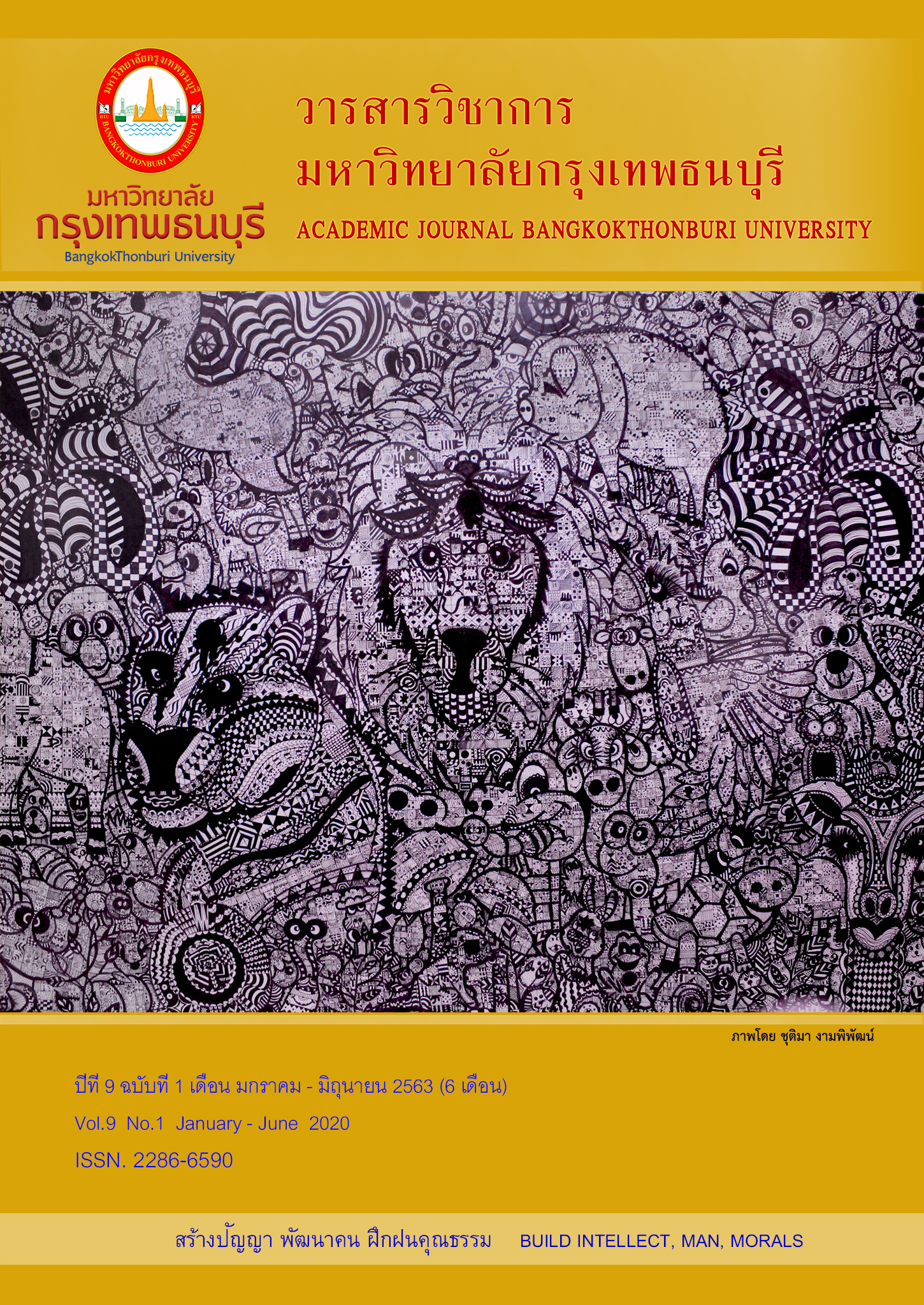The Suitable Strategy for Business Succession of Offered at Basic Educational Level in Private Schools of Thailand
Main Article Content
Abstract
This research was designed to examine the suitable strategy for business succession of private schools in Thailand and test the Possibility in Applying. The mixed methodology were design in this study, the process was comprised of two phases : first phase consisted of documentary analysis concerning family business succession and interpretation of data analysis in order to figure out the guidelines for business succession of private schools via Delphi Technique with the 18 key informants.The data were analyzed in this stage by contents analysis and statistical using median, mode and interquartile range.The second phase was studied the guideline for business succession of private schools.The sample were 360 owners of private schools which selected by proportional stratified random sampling method. The instrument was 5-level rating scale questionnaire. Data were analyzed by mean, standard deviation and one sample t-test.
The research findings were as follows:
1. There were 7 major strategies for business succession of private schools in Thailand: (1) business succession planning; (2) communication for generating business successor; (3) family governance; (4) determining business successor; (5) developing business successor’s readiness; (6) changing roles of business successor and business owner and (7) transferring business control and ownership of assets.
2. The level of the results obtained from study the possibility of implementing the suitable strategy for business succession of private schools in Thailand was highly statistical significant at .05 as a whole and in each element.
Article Details
References
กิติพงศ์ อุรพีพัฒนพงศ์. (2554). วางแผนสืบทอดธุรกิจ ครอบครัวอย่างยั่งยืน. กรุงเทพฯ: ตลาดหลักทรัพย์ แห่งประเทศไทย.
คณะผู้บริหารสำนักงานคณะกรรมการส่งเสริมการศึกษาเอกชน (2560). แนวทางการดำเนินงานของสำนักงานคณะกรรมการส่งเสริมการศึกษาเอกชน. สไลด์ประกอบการประชุมสัมมนาขับเคลื่อนการศึกษาเอกชนตามแนวทางการปฏิรูปการศึกษาของกระทรวงศึกษาธิการ. กรุงเทพมหานคร: สำนักงานคณะกรรมการส่งเสริมการศึกษาเอกชน.
ชัยลิขิต สร้อยเพชรเกษม. (2555). การวิจัยด้วยเทคนิคเดลฟาย: การใช้มติสอดคล้องโดยเสียงข้างมาก. วารสารวิชาการบัณฑิตศึกษา มหาวิทยาลัยราชภัฎนครสวรรค์, 7(18), 1-13.
ดนัย เทียนพุฒ. (2558). ก้าวย่างสานต่อธุรกิจครอบครัว. กรุงเทพฯ: โครงการ Human Capital.
ธีระ กนกกาญจนรัตน์. (2557). สืบทอดธุรกิจอย่างไรให้ยั่งยืน. สืบค้นเมื่อ 21 กันยายน 2558 จาก ไทยรัฐออนไลน์: http://www.thairath. co.th/ content/443190
รวิดา วิริยกิจจา. (2559). การจัดการกลยุทธ์ธุรกิจครอบครัว. เอกสารประกอบการอบรมหลักสูตรการจัดการธุรกิจครอบครัวเพื่อความยั่งยืนสำหรับกลุ่มผู้บริหารโรงเรียนเอกชน. กรุงเทพฯ: สถาบันวิจัยการเรียนรู้.
สิริรัฐ บุญรักษา. (2559). ธรรมนูญครอบครัว ปฐมบทแห่งความยั่งยืน. เอกสารประกอบการอบรมหลักสูตรการจัดการธุรกิจครอบครัวเพื่อความยั่งยืนสำหรับกลุ่มผู้บริหารโรงเรียนเอกชน. กรุงเทพฯ: สถาบันวิจัยการเรียนรู้.
สำนักงานคณะกรรมการพัฒนาระบบข้าราชการ. (2552). การจัดทำแผนยุทธศาสตร์ตามแนวทางของสำนักงาน ก.พ.ร. สืบค้นเมื่อ 14 มิถุนายน 2560 จาก http://www.pharmacy.cmu.ac.th/unit/ unit_files/files_data/2013-07-24strategic-plan-technic-2552.pdf
สำนักงานคณะกรรมการส่งเสริมการศึกษาเอกชน. (2559). รายชื่อโรงเรียนเอกชน. สืบค้นเมื่อ 19 ตุลาคม 2559 จาก https://sites.google. com/a/opec.go.th/ opec/list-name-school
หนังสือพิมพ์มติชน. (2558, 2 มกราคม). โรงเรียนเอกชนวิกฤต! ปิดแล้ว 400 ขาดครู-ค่าใช้จ่ายสูง-รัฐเมิน.สืบค้นเมื่อ 17 กันยายน 2558 จาก มติชนออนไลน์: http://www.matichon.co.th/ news_detail. php?newsid=1420172401
อุทัย ดุลยเกษม. (2547). ปรารมภ์เรื่องความเข้มแข็งของสถาบันอุดมศึกษาเอกชน. สานปฏิรูป, 6(69), 62-63.
เอกชัย อภิศักดิ์กุล. (2557 ก). การวางแผนสืบทอดธุรกิจรุ่นต่อรุ่น. นิตยสารเศรษฐกิจและธุรกิจรายเดือน Thailand Economic and Business Review, 10(11), 53-57.
Aronoff, C. E. & Ward, J. L. (1992). Family Business Succession: The Final Test of Greatness. Marietta, GA: Family Enterprise Publishers.
Churchill, N.C., & Hatten, K.J. (1987). Non-market -based transfers of wealth and power: a research framework for family businesses. American Journal of Small Business, 11(3), 51-64.
Floren, R. H. (2002). Crown prince in the clay: An empirical study on the tackling of succession challenges in Dutch family farms. Assen, The Netherlands: Royal Van Gorcum.
Handler, W. C. (1994). Succession in Family Business: A Review of the Research. Family Business Review, 7(2), 133-157.
Kenyon-Rouvinez, D. & Gabs. (2007). Who, Me? Family Business Succession. A Practical Guide for the Next Generation. Georgia: Family Enterprise Publishers.
Lea, J. W. (1991). Keeping It in the Family: Sucessful Succession of the Family Business. New York: Wiley & Sons.
Poza, E. J. (2010). Family Business. (3rd ed.). Mason: South-Western.
PricewaterhouseCoopers. (2014). Bridging the gap: Handing over the family business to the next generation. Retrieved September 7, 2015, from pwc: http://www.pwc.com/gx/en/pwc-family-business-survey/next-gen/assets/nextgen-survey.pdf
Venter, E., Boshoff, C., & Mass, G. (2005). The influence of succession process in small and medium-sized family businesses Family Business Review, 18(4), 283-303.
Yamane, T. (1973). Statistic: An Introductory Analysis. (3rd ed.). New York: Harper and Row.


